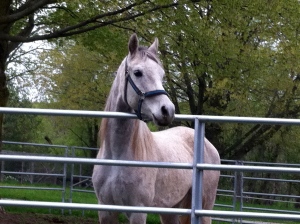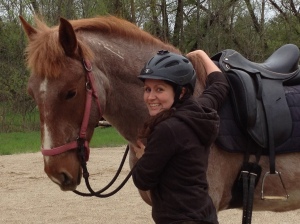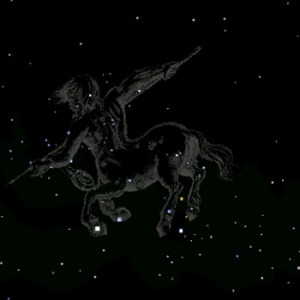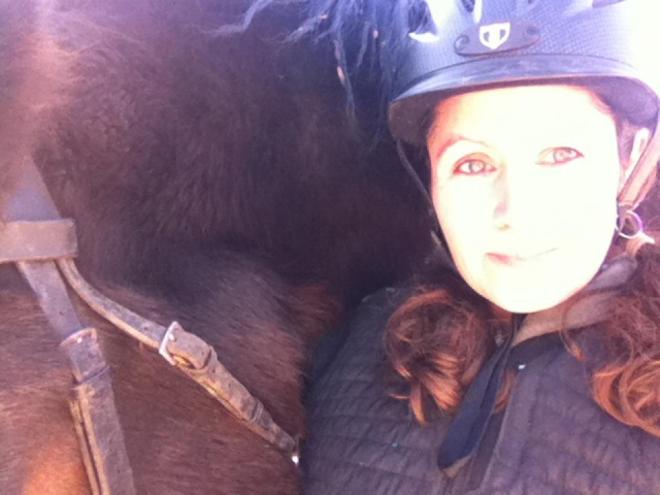This spring I was lucky enough to purchase a horse who I loved many years ago but thought I would never own. Hocus Pocus is a tall, black and white, Saddlebred/Friesian cross who was mine to train from the ages of two to three. Even as a  two-year-old, he was the sort of horse who was thoughtful and kind. He was such a good learner, and so easy to train, that I called him my “yes” horse. I wanted very badly to buy him for myself but he had been purchased to prepare for sale, and I knew I could never afford him. This year, seven years from the last time I saw him, his owner now with both a young child and a business to run, decided she just couldn’t offer him the time she felt he deserved. When she contacted me to say he was for sale, I arranged to go see him with a check and a trailer. I wanted to welcome him here at Idle Moon Farm to join the rest of my family.
two-year-old, he was the sort of horse who was thoughtful and kind. He was such a good learner, and so easy to train, that I called him my “yes” horse. I wanted very badly to buy him for myself but he had been purchased to prepare for sale, and I knew I could never afford him. This year, seven years from the last time I saw him, his owner now with both a young child and a business to run, decided she just couldn’t offer him the time she felt he deserved. When she contacted me to say he was for sale, I arranged to go see him with a check and a trailer. I wanted to welcome him here at Idle Moon Farm to join the rest of my family.
The horse I saw when I went to pick up Hocus was obedient but rather checked-out. Instead of looking like a mature ten-year-old in his prime, he looked more like an aged horse. His back was dropped and his topline was completely wasted away. I hesitated when I saw him, but was set on bringing him home. We would address whatever physical issues were going on; I had decided there were no deal breakers when it came to him, though I wondered if my “yes” horse was still in there. Here’s a picture of his back the first week I brought him home:
 You can see that the top of the individual vertebrae are visible, as well as the top of his sacro-iliac joint and a very prominent point of hip. He was going to need some serious conditioning to put muscle back in the right places and make sure he became stronger instead of stiffening into this muscular imbalance. People often believe, as I used to, that turning a horse out to pasture for six months or a year helps them to loosen up and heal. But the truth is horses turned out to pasture tend to reinforce the same muscular patterns they had going into the time off. Six months or a year out to pasture often yields a horse who has the same crookedness or weakness, sometimes more pronounced, in addition to them then being out of shape. I wanted to start changing the muscles Hocus Pocus used in movement, preferably with a good head start before winter. I wanted him to have some mass to take him through the cold and over the slippery spots.
You can see that the top of the individual vertebrae are visible, as well as the top of his sacro-iliac joint and a very prominent point of hip. He was going to need some serious conditioning to put muscle back in the right places and make sure he became stronger instead of stiffening into this muscular imbalance. People often believe, as I used to, that turning a horse out to pasture for six months or a year helps them to loosen up and heal. But the truth is horses turned out to pasture tend to reinforce the same muscular patterns they had going into the time off. Six months or a year out to pasture often yields a horse who has the same crookedness or weakness, sometimes more pronounced, in addition to them then being out of shape. I wanted to start changing the muscles Hocus Pocus used in movement, preferably with a good head start before winter. I wanted him to have some mass to take him through the cold and over the slippery spots.
The first order of business was to get Hocus moving throughout the day, so he could do lots of walking and start to build up some muscle through easy, low-impact exercise. Once he was worked onto grass, we let him out onto our track system so he could walk and graze alongside the other horses. Having his head down kept him released over his back and allowed his tight, weak muscles to move through their range of motion and build up some strength. Having a paddock set up that allowed him to move as continuously as possible all day long provided much more movement than one human trying to exercise him ever could.
The second order of business was to teach Hocus Pocus a new way to carry himself posturally. He tends to be nervous in the arena, his head flies up, his back inverts and he braces his big brachiocephalic muscle on the underside of his neck. This tension limits his range of motion, stresses his joints and continues to atrophy the back muscles he needs for healthy  locomotion. To begin to change his habits, I taught him to lower his head in the halt from the ground. The head-down behavior serves a dual purpose: it allows Hocus to self-calm by giving him a measurable behavior to concentrate on in the arena and it is the new gross motor pattern I want him to generalize and offer. There are other bells and whistles to add on, but the main pieces are there: lengthen your neck and release over your back. Before adding bend or asking for any other nuances in the way he moves, I want him to know one thing for sure: a lengthened topline is the right answer. When in doubt, start there. Click. Treat.
locomotion. To begin to change his habits, I taught him to lower his head in the halt from the ground. The head-down behavior serves a dual purpose: it allows Hocus to self-calm by giving him a measurable behavior to concentrate on in the arena and it is the new gross motor pattern I want him to generalize and offer. There are other bells and whistles to add on, but the main pieces are there: lengthen your neck and release over your back. Before adding bend or asking for any other nuances in the way he moves, I want him to know one thing for sure: a lengthened topline is the right answer. When in doubt, start there. Click. Treat.
At first we spent most of our time in the arena in the halt in the head-down behavior. Every time I asked him to walk off his head would fly up and he would take short tense steps. After three or four steps, I would click him just for staying with me regardless of the quality of the movement and we would go back into our deep meditation within the head-down behavior. I would ask him to do three to five repetitions of the behavior, clicking and treating each one, until he felt calm and centered and ready to walk off again. Hocus Pocus had been caught in a vicious cycle. He was naturally a bit “startle-y”, which caused him to tense and tighten. The tightening and tensing up made his body uncomfortable, which caused him to spook and startle even more. Left to his own natural inclinations with no support or new learned response, he was only going to reinforce his old, habitual patterns of fear and unhealthy movement. Head-down offered him room to begin to change shape emotionally and physically. In this deceptively simple behavior there was space for a new horse to emerge. Since the behavior was taught and maintained with clicker training, there was the added relaxation of food and fun woven into the training sessions. Lightbulbs went off. Soon, Hocus Pocus was able to start lowering his head in the walk from a gentle slide on the lead. Soon after that, he was able to offer more and more steps in walk with a lowered head and his back  muscles working in relaxation. Soon after that, he began to breathe normally again in the arena space and he stopped spooking at noises and counter-bending to swivel his head around to look in every corner for danger. Very soon, I had a true partner who was motivated, relaxed and an absolute pro at stretching over his topline and keeping step with me. The entire process took roughly four weeks.
muscles working in relaxation. Soon after that, he began to breathe normally again in the arena space and he stopped spooking at noises and counter-bending to swivel his head around to look in every corner for danger. Very soon, I had a true partner who was motivated, relaxed and an absolute pro at stretching over his topline and keeping step with me. The entire process took roughly four weeks.
Some people fear repetition, but to really build a reinforcement history on a behavior, to make it a place where you and your horse can check-in, discuss how tight or relaxed they are, to use it as an anchor in a storm, takes repetition. Thoughtful repetition is necessary for robust learning and really cementing new neural pathways. 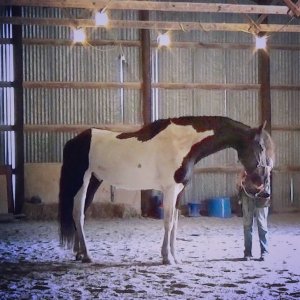 Practice makes permanent. The reinforcement history we have built around head-down has made it an absolute favorite of Hocus Pocus and he even offers it when walking at liberty from his side paddock back to where he sleeps at night. It’s not just a motor pattern, it’s a request to be paid some grain, a way to self-soothe, physical therapy and a easy conversation we have with tiny nuances being added all the time. Head-down is familiar now. It’s valuable to Hocus. It’s useful to me. It feels good to both of us. It has changed the shape, nuance and energy of all of our work together. And most importantly, it’s already begun to change the shape of his back. Here’s a comparison photo from our first week together, (left) and almost four months later, (right.)
Practice makes permanent. The reinforcement history we have built around head-down has made it an absolute favorite of Hocus Pocus and he even offers it when walking at liberty from his side paddock back to where he sleeps at night. It’s not just a motor pattern, it’s a request to be paid some grain, a way to self-soothe, physical therapy and a easy conversation we have with tiny nuances being added all the time. Head-down is familiar now. It’s valuable to Hocus. It’s useful to me. It feels good to both of us. It has changed the shape, nuance and energy of all of our work together. And most importantly, it’s already begun to change the shape of his back. Here’s a comparison photo from our first week together, (left) and almost four months later, (right.) 
Hocus and I have only just begun this new leg of our journey together. It’s so rare to get anything back that you have lost; he is the first second-chance I have had in my life. I want to honor him by keeping him healthy, helping him to be strong and teaching him how to relax and truly love his work.








